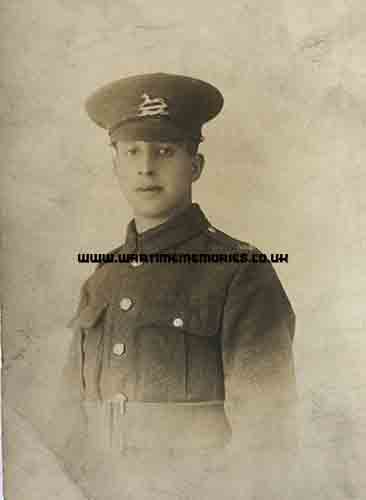Additions will be checked before being published on the website and where possible will be forwarded to the person who submitted the original entries. Your contact details will not be forwarded, but they can send a reply via this messaging system.
please scroll down to send a message
L/Cpl. Lewis Earnshaw
British Army 10th Btn. West Yorkshire Regiment
from:53 Leeds Road North, Huddersfield
(d.1st July 1916)
This photograph was found in my parents' papers. I identified Lewis Earnshaw by comparing it to a photograph of him printed in the Huddersfield Weekly Examiner on 5th August 1916. I believe he was a neighbour of my great grandparents. In 1911 he was a warehouseman for a cotton spinner.
Additional Information:
In the past I’ve often wondered whether I had an ancestor who died during the Great War. It turns out that I have. Lewis was my dad’s great uncle, and so my great-great uncle. He was 27 when he was killed – on the first day of the “Big Push”, the massive Somme Offensive that took so many men’s lives. Lewis was part of the 10th Battalion the West Yorkshire Regiment (the Prince of Wales’ Own), which had the dubious honour of being almost completely wiped out on the morning of July 1, 1916. I found this extract from the unit’s War Diary online. It makes for grim reading: “At 7.30am the battalion took part in the grand assault, the objective being as in the attached orders. On the right were the 7th Division and on the left the 21st Division. The battalion assaulted in four lines. Two lines got through the German positions to the fourth line and were cut off, the attack on our left having failed. Casualties were very heavy, chiefly caused by machine guns which enfiladed our left flank and were so deadly that the third and fourth lines failed to get across “no man’s land”. 27 officers casualties including Lt Col Dixon and Major J Knott second in command (both killed) and approximately 750 other ranks. The battalion was then withdrawn to Ville.”
What is there to say about this? What can be said? The massive artillery bombardment that preceded the attack was a failure despite the promises by army top brass that German positions would be utterly destroyed. They were not. Quite the opposite, in fact. The enemy emerged from the safety of their dugouts and opened fire on British troops as they advanced across open no man’s land. The precision and range of the German machine guns meant they could hit a target a mile away. Our soldiers were mown down in waves. Some barely made it out of their trenches. Others were killed as they attempted to leave support trenches. Two years of training boiled down to mere moments on the battlefield. Such was the enormity of industrialised warfare.
Bradley-born Lewis, formerly a locomotive cleaner at the Hillhouse sheds near what is now Kirklees Waste Recycling Centre, probably died in such horrific circumstances, cut down in a hail of bullets before he’d managed to walk - walk - a few yards. And he was just one of hundreds of fatalities. The sheer enormity of the Great War is impossible to grasp but it has a deep and tangible meaning when one recognises the personal connections. The official battalion war diary for July 1, 1916 records losses as 750 soldiers and 27 officers killed, missing and wounded. At dawn that day the 10th Battalion had begun its attack with around 900 men. By nightfall it numbered barely more than 125. One historian put it more starkly: “The men were walking into a wall of machine gun fire. These two waves of men were virtually annihilated. Those who had reached German trenches earlier in the offensive had to make their way back across no man’s land without support, resulting in more casualties.”
That poor lad, and all his brave pals. What a waste. And so Lewis Earnshaw never returned home to Bradley, to his mother, to his job. His name was recorded on a Roll of Honour in St Thomas’ Church - now a gymnasium - a few hundred yards from his birthplace in Oak Road. Today, and for the last 100 years, he rests in the Commonwealth War Graves Commission cemetery at Dantzig Alley (named after a German trench) close to the village of Mametz in France.
In learning of Lewis, his life and death, I have made myself a promise. I will embark upon the needle-in-a-haystack search to find the Victory Medal that would have gone to his mother at war’s end, along with the memorial plaque engraved with his name. I will travel to the Somme to walk in his bootprints in no man’s land which, in my mind’s memory, echoes with the awful cacophony of machine gun fire. And in tribute to a young man snatched from existence 50 years before I was born, I will lay flowers at his grave.
Tony Earnshaw
